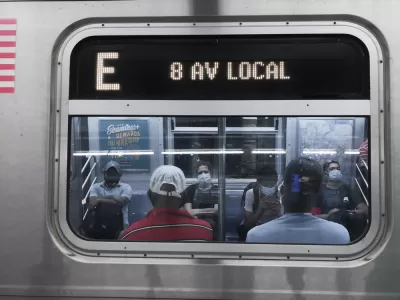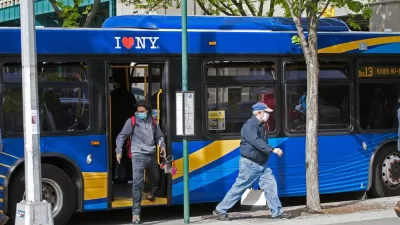Public transit agencies are getting creative in the effort to bring riders back to buses and trains.

"Starting March 1, officials intend to put a weekly fare cap on trips made with OMNY, the 'tap-and-go' fare system," reports Ana Ley for The New York Times.
The threshold for unlimited rides in a seven day period will be set at $33, according to Ley.
The new fare cap is intended to lure riders back to public transit in New York City, where ridership hasn't fully recovered to pre-pandemic levels. Depending on the popularity of the program, and its effects on the Metropolitan Transportation Authority's budget, the fare cap could also be made permanent. For now, the program is scheduled to expire on June 30.
"Although the numbers in New York are climbing, subway ridership in recent weeks has only been hovering at about 58 percent of prepandemic levels, when over five million people packed the trains every weekday," writes Ley.
The state of public transit in the United States at the conclusion of 2021 is tenuous: driver shortages are contributing to service cuts in cities all over the country, and an infusion of federal money has buoyed agencies through declines in ridership and a resulting loss of revenue. Some cities are experimenting with free, or reduced-fare, transit as an enticement to get riders back on buses and trains.
FULL STORY: To Win Riders Back, M.T.A. to Offer Free Rides for ‘Tap-and-Go’ Customers

Alabama: Trump Terminates Settlements for Black Communities Harmed By Raw Sewage
Trump deemed the landmark civil rights agreement “illegal DEI and environmental justice policy.”

Planetizen Federal Action Tracker
A weekly monitor of how Trump’s orders and actions are impacting planners and planning in America.

The 120 Year Old Tiny Home Villages That Sheltered San Francisco’s Earthquake Refugees
More than a century ago, San Francisco mobilized to house thousands of residents displaced by the 1906 earthquake. Could their strategy offer a model for the present?

In Both Crashes and Crime, Public Transportation is Far Safer than Driving
Contrary to popular assumptions, public transportation has far lower crash and crime rates than automobile travel. For safer communities, improve and encourage transit travel.

Report: Zoning Reforms Should Complement Nashville’s Ambitious Transit Plan
Without reform, restrictive zoning codes will limit the impact of the city’s planned transit expansion and could exclude some of the residents who depend on transit the most.

Judge Orders Release of Frozen IRA, IIJA Funding
The decision is a victory for environmental groups who charged that freezing funds for critical infrastructure and disaster response programs caused “real and irreparable harm” to communities.
Urban Design for Planners 1: Software Tools
This six-course series explores essential urban design concepts using open source software and equips planners with the tools they need to participate fully in the urban design process.
Planning for Universal Design
Learn the tools for implementing Universal Design in planning regulations.
Clanton & Associates, Inc.
Jessamine County Fiscal Court
Institute for Housing and Urban Development Studies (IHS)
City of Grandview
Harvard GSD Executive Education
Toledo-Lucas County Plan Commissions
Salt Lake City
NYU Wagner Graduate School of Public Service





























